ENDOVASCULAR TREATMENT OF THE BRAIN ANEURYSMS
 |
The word aneurysm comes from a Latin term meaning «dilation.» An aneurysm is an anomaly, or an enlargement in the wall of a blood vessel. A cerebral aneurysm is a bulging, weakened area (or dilated) in the side wall of a cerebral artery, like a very thin balloon or a weakened part of an inner tube. Aneurysms form from the deterioration of the arteries, or less commonly, injury or infection. Saccular aneurysms or «berry aneurysms» are the most common type of cerebral aneurysm and usually require treatment.
|
|
Wall of a brain aneurysm
|
After assessing all the clinical examinations and tests, we will recommend the treatment that has the biggest chance of success and the smallest risk for you. Sometimes the endovascular therapy is the safest and most effective treatment modality, but in others it is the open surgery.
Endovascular therapy (which means «within blood vessel») uses the natural access to the brain through the bloodstream (arteries) to diagnose and treat brain aneurysms. The goal of treatment is to safely seal the aneurysm preventing rupture and bleeding, or avoiding its re-bleeding.
What is endovascular therapy?
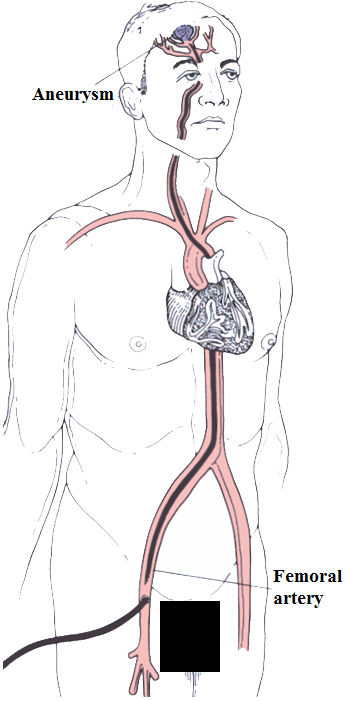 |
The goal of the endovascular therapy is to safely and permanently seal all communication between the mother artery (artery from which the aneurysm has originated) and the aneurysm. To do so a small catheter is introduced in the groin, through which navigate within the blood vessel will take place to locate the aneurysm. Once there, a wire winding or coil is inserted, with the purpose of inducing the blood to clot inside the aneurysm. This will cause the aneurysm to isolate from the bloodstream, preventing further bleeds. Sometimes a small balloon is placed inside the aneurysm or inside the blood vessel where the aneurysm lays. |
|
Endovascular treatment of the brain aneurysms
|
Its advantage is that it does not require opening the skull, but it also has drawbacks. Not all aneurysms can be occluded safely with a coil. However, even if the aneurysm is occluded initially, over time it can re-canalize and show again risk of bleeding. A further disadvantage is that sometimes the blood vessels can become blocked, causing a stroke.
The best treatment in each case, open surgery or endovascular, depends on the characteristics of the aneurysm, the patient’s general condition and the possible co-existence of other diseases, that induce that in this particular case the risk is lower either with craniotomy or with endovascular treatment.
How is the procedure performed?
Your groin will be sterilized and shaved, usually both sides, to provide a sterile access to the underlying femoral arteries.
A small incision in the skin, about 6 mm over the artery in the groin, is performed and a needle used to pierce the blood vessel. Then a sheath (thin hollow tube) is inserted into the artery, allowing continuous access to it.
Through a catheter (hollow plastic tube) and a guide wire, we will navigate inside the arteries until reaching the inside of the aneurysm. The cable is removed and a contrast agent injected into the bloodstream to provide a clear picture of the normal blood vessels and of the aneurysm.
The whole procedure is performed under continuous X-ray monitoring. Once we have confirmed the size and location of the aneurysm, a «micro-catheter» is inserted in the initial catheter. The micro-catheter is then guided to the neck of the aneurysm, and several coils inserted. When the aneurism is filled with coils, the guide wire is removed, as well as all the catheters used to insert them.
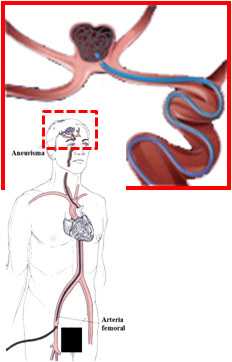 |
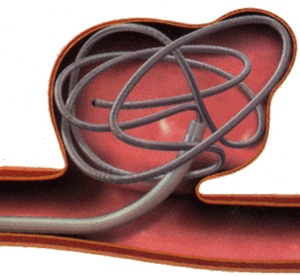 |
 |
|
Intravascular access to the aneurysm
|
Start of filling of the aneurysm with coils
|
Aneurysms completely filled with coils
|
According to the anatomy, shape, size and location of the aneurysm, the embolization with coils may be assisted with other devices. In some cases a stent is required to keep the coils inside the aneurysm. In other cases, a balloon has to be inflated temporarily to keep the coils inside the aneurysm.
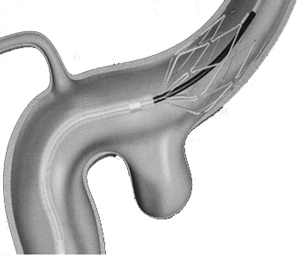 |
 |
 |
|
Stent inserted to prevent the coils from going out from inside the aneurysm
|
Stent inserted to prevent the coils from going out from inside the aneurysm
|
Stent inserted to prevent the coils from going out from inside the aneurysm
|
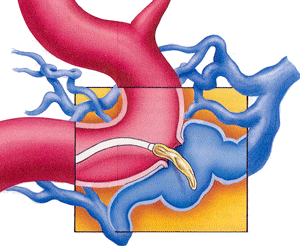 |
 |
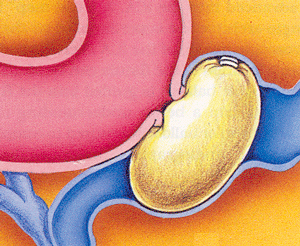 |
|
Balloon used to block an aneurysm inside the cavernous sinus
|
Balloon used to block an aneurysm inside the cavernous sinus
|
Balloon used to block an aneurysm inside the cavernous sinus
|
Post-operative care
Once the embolization is over, the patient will be watched and monitored in the intensive care unit or recovery room, depending on each individual case. The procedure can be performed with local or general anaesthesia. This second case is more common in children and seriously ill patients.
You may need to keep your leg straight for a while after the procedure, depending on the method used by us on removing the catheter from the artery in your groin.
The time spent in hospital varies. Generally, patients return home the morning after the procedure, but others must stay longer in hospital, according to the circumstances of the case and if the aneurysm has bled or not.
Recovery
Once back at home, the recovery process starts. It can be short or long, depending on the severity of each particular case. The length of recovery varies from patient to patient.
Headaches are very common. Remember, treatment of the aneurysm with coil embolization was not carried out to eliminate the headaches, but to avoid serious problems, even death, in case of further bleeding.
Angiographic control after endovascular treatment
The aneurysms embolized with coils, in general, should undergo regular monitoring by a new angiography to assess the stability of the coils and make sure the aneurysm does not grow back.